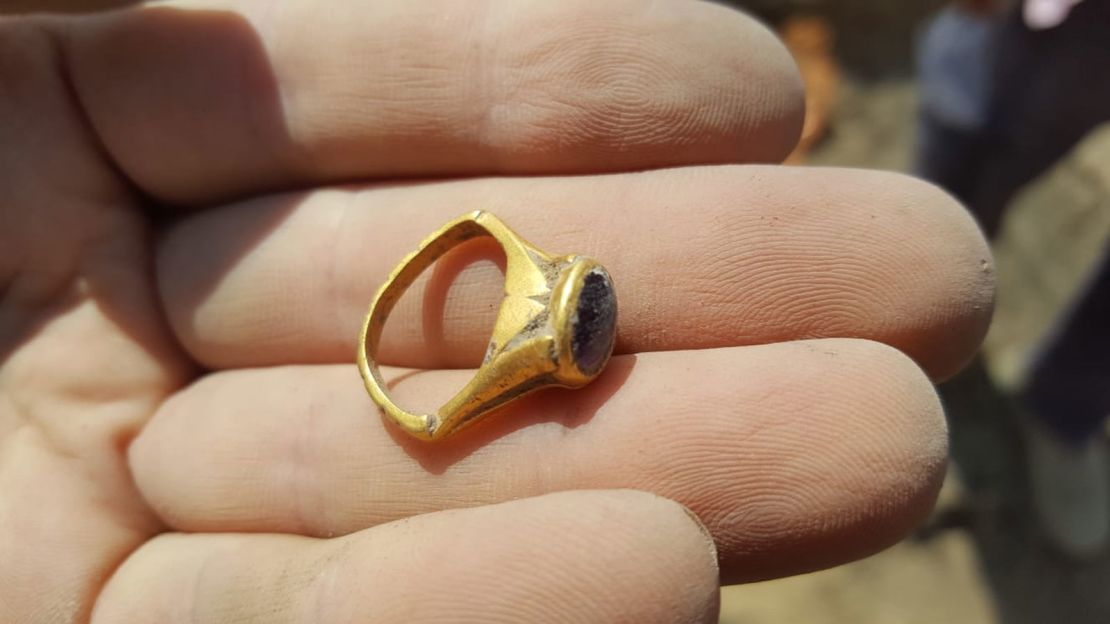Ancient Hangover Cure Unveiled: Byzantine Ring with Amethyst Discovered in Israel

Discovery at Yavne

The ring was excavated from Yavne, a city with a rich history, particularly noted for being the site of the largest known Byzantine-era winery. According to the Israel Antiquities Authority, this ancient artifact was unearthed near the remains of a warehouse that once housed amphorae, large jars used for storing wine. This discovery, situated approximately 150 meters (492 feet) from the winery, suggests that the ring was closely linked to the wine industry of the time.
Significance of Amethyst
Amethyst, a purple gemstone, was believed to possess various virtues in antiquity. Archaeologist Amir Golani highlighted that this gemstone was reputed to counteract the side effects of alcohol consumption, including hangovers. “Many virtues have been attached to this gem,” Golani remarked, noting its association with preventing the adverse effects of drinking. This belief in amethyst’s protective qualities aligns with its historical use in both Roman and Byzantine cultures.
Historical Context and Speculation

The ring’s excavation site has been dated to around the 7th century, marking the transition from the Byzantine era to the Early Islamic period. However, it is possible that the ring could be even older, potentially from as early as the 3rd century CE. Gold rings inlaid with amethyst were known in the Roman world, suggesting that this particular piece might have belonged to an elite member of society.
Golani speculated that the ring was likely owned by someone affluent, as the presence of such jewelry typically indicated status and wealth. “The wearing of the jewel indicated their status and wealth,” Golani explained. “Such rings could be worn by both men and women.” Elie Haddad, a co-director of the excavation, suggested that the ring could have belonged to the owner of the winery, a foreman, or even an unfortunate visitor who lost it.
Ancient Hangover Remedies

The amethyst ring is not the only ancient remedy for hangovers. In 2015, researchers uncovered a 1,900-year-old Greek papyrus that described a necklace of laurel leaves as a cure for drunken headaches. Similarly, in ancient Mesopotamia, a physician recommended a concoction of licorice, oleander, beans, oil, and wine for those suffering from the effects of strong wine.
Conclusion
The discovery of this ancient amethyst ring provides a fascinating glimpse into the past, revealing how historical cultures sought to address the common problem of hangovers. Whether worn for its purported protective properties or as a symbol of status, this artifact underscores the enduring human quest for relief from the consequences of indulgence. As we continue to unearth and study such relics, they offer valuable insights into the daily lives and beliefs of our ancestors, enriching our understanding of history and its ongoing influence on modern practices.
Video
News
The Hanging Temple: China’s 1,500-Year-Old Cliffside Marvel of Faith and Engineering
The Hanging Temple: China’s 1,500-Year-Old Cliffside Marvel of Faith and Engineering Perched precariously on the cliffs of Mount Heng in Shanxi Province, China, the Hanging Temple, also known as Xuankong Temple, Hengshan Hanging Temple, or Hanging Monastery, is an architectural…
The Willendorf Venus: A 30,000-Year-Old Masterpiece Reveals Astonishing Secrets
The Willendorf Venus: A 30,000-Year-Old Masterpiece Reveals Astonishing Secrets The “Willendorf Venus” stands as one of the most revered archaeological treasures from the Upper Paleolithic era. Discovered in 1908 by scientist Johann Veran near Willendorf, Austria, this small yet profound…
Unveiling the Maya: Hallucinogens and Rituals Beneath the Yucatán Ball Courts
Unveiling the Maya: Hallucinogens and Rituals Beneath the Yucatán Ball Courts New archaeological research has uncovered intriguing insights into the ritual practices of the ancient Maya civilization. The focus of this study is a ceremonial offering found beneath the sediment…
Uncovering the Oldest Agricultural Machine: The Threshing Sledge’s Neolithic Origins
Uncovering the Oldest Agricultural Machine: The Threshing Sledge’s Neolithic Origins The history of agricultural innovation is a fascinating journey that spans thousands of years, and one of the earliest known agricultural machines is the threshing sledge. Recently, a groundbreaking study…
Nara’s Ancient Sword: A 1,600-Year-Old Protector Against Evil Spirits
Nara’s Ancient Sword: A 1,600-Year-Old Protector Against Evil Spirits In a remarkable discovery that has captured the attention of archaeologists and historians alike, a 7.5-foot-long iron sword was unearthed from a 1,600-year-old burial mound in Nara, Japan. This oversized weapon,…
The Inflatable Plane, Dropped Behind the Lines for Downed Pilots
Experimental The Inflatable Plane, Dropped Behind the Lines for Downed Pilots The Inflatoplane from Goodyear was an unconventional aircraft developed by the Goodyear Aircraft Company, a branch of the renowned Goodyear Tire and Rubber Company, also famed for the Goodyear…
End of content
No more pages to load











